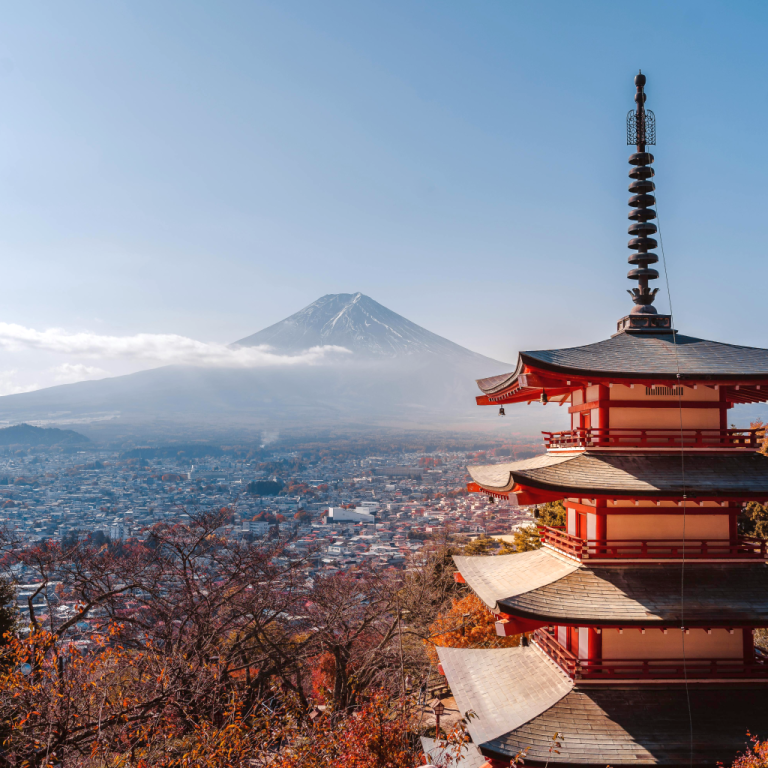Mount Fuji, or Fujisan in Japanese, is not just a mountain; it’s a symbol of Japan itself. This majestic peak, rising to 3,776 meters (12,389 feet), is the highest in Japan and one of the most iconic and recognized mountains in the world. Its symmetrical cone shape, often capped with snow, has inspired artists, poets, and travelers for centuries. Located on Honshu Island, about 100 kilometers southwest of Tokyo, Mount Fuji holds immense cultural, spiritual, and natural significance.
Geological and Physical Characteristics
Mount Fuji is a stratovolcano, formed through a series of eruptions over the past several hundred thousand years. It last erupted in 1707 during the Edo period, in what is known as the Hoei eruption. The volcano is composed of basalt and andesite, and its distinctive cone shape is the result of repeated volcanic activity and the layering of ash, lava, and other volcanic material.
The mountain is surrounded by five lakes—Kawaguchi, Yamanaka, Sai, Shoji, and Motosu—collectively known as the Fuji Five Lakes. These lakes, along with the nearby Aokigahara Forest, add to the region’s natural beauty and provide a range of outdoor recreational activities.
Cultural and Spiritual Significance
Mount Fuji is deeply embedded in Japanese culture and spirituality. It is considered one of Japan’s “Three Holy Mountains” (Sanreizan) alongside Mount Tate and Mount Haku. For centuries, it has been a site of pilgrimage. The practice of climbing Mount Fuji, known as “Fujisan Tozan,” has spiritual roots, with the ascent symbolizing purification and a journey towards enlightenment.
The mountain features prominently in Japanese art and literature. It is famously depicted in Katsushika Hokusai’s “Thirty-Six Views of Mount Fuji,” a series of woodblock prints that capture the mountain from various perspectives and seasons. These prints highlight the mountain’s changing appearance and its integration into the daily lives of the Japanese people.
Climbing Mount Fuji
Climbing Mount Fuji is a bucket-list experience for many. The official climbing season is from early July to early September, when the weather conditions are most favorable. During this period, the mountain is free of snow, and the mountain huts and facilities are open to accommodate climbers.
There are four main trails to the summit: Yoshida, Subashiri, Gotemba, and Fujinomiya. The Yoshida Trail is the most popular, starting from the Fuji Subaru Line 5th Station. This route offers a well-developed infrastructure with numerous huts and rest stations along the way.
Climbers typically start their ascent in the afternoon, aiming to reach the summit in time to witness the sunrise, a practice known as “Goraiko.” Watching the sunrise from the summit of Mount Fuji is a deeply moving experience, symbolizing new beginnings and enlightenment.
Flora and Fauna
Despite its harsh volcanic landscape, Mount Fuji supports a diverse range of flora and fauna. The lower slopes are covered in dense forests of Japanese cypress, red pine, and hemlock. As the elevation increases, the vegetation changes, with alpine plants and flowers, such as the Fujizakura (Fuji cherry blossoms), dotting the landscape.
The mountain is home to various wildlife, including Japanese macaques, sika deer, and the elusive Japanese serow. Birdwatchers can spot species such as the Japanese woodpecker, Japanese grosbeak, and the mountain hawk-eagle.
Preservation and Environmental Concerns
Mount Fuji’s popularity as a tourist destination has led to environmental challenges. The large number of climbers and visitors has resulted in issues like littering, trail erosion, and the need for improved waste management. Efforts are ongoing to preserve the mountain’s natural beauty and ecosystem. Local authorities and volunteer groups conduct regular clean-up operations, and climbers are encouraged to follow the principle of “leave no trace.”
In 2013, Mount Fuji was designated a UNESCO World Heritage Site, recognizing its cultural significance and the need for its protection. This designation has helped boost conservation efforts and raise awareness about the importance of sustainable tourism.
Surrounding Attractions
The area surrounding Mount Fuji offers numerous attractions and activities for visitors. The Fuji Five Lakes region provides opportunities for boating, fishing, and hiking. Lake Kawaguchi, in particular, offers stunning views of Mount Fuji and is a popular spot for photographers.
The Fuji-Q Highland amusement park, located near the base of the mountain, features thrilling roller coasters and attractions with panoramic views of Mount Fuji. The Oshino Hakkai, a set of eight ponds fed by the snowmelt from Mount Fuji, is another must-visit site, known for its clear waters and traditional thatched-roof houses.
Conclusion
Mount Fuji is more than just Japan’s highest mountain; it is a symbol of the nation’s natural beauty, cultural heritage, and spiritual depth. Its awe-inspiring presence has captivated people for centuries, drawing climbers, artists, and travelers from around the world. Whether viewed from afar, climbed to its summit, or explored in its surrounding regions, Mount Fuji continues to inspire and enchant, standing as a timeless testament to Japan’s enduring connection to nature and spirituality.
Visiting Mount Fuji offers a unique opportunity to experience a blend of natural wonder and cultural richness. As efforts to preserve and protect this iconic landmark continue, future generations will be able to appreciate its splendor and significance, ensuring that Mount Fuji remains a cherished symbol of Japan for years to come.






